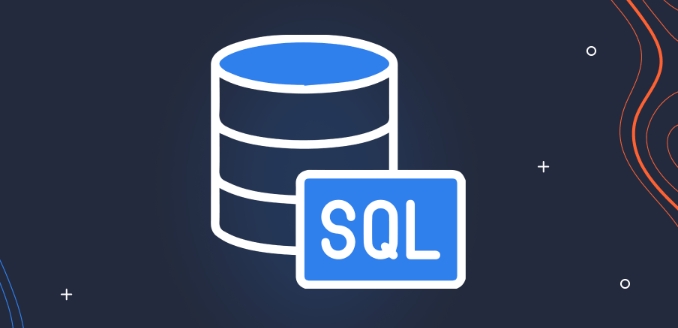In predictive analysis, SQL can complete data preparation and feature extraction. The key is to clarify the requirements and use SQL functions reasonably. Specific steps include: 1. Data preparation requires extracting historical data from multiple tables and aggregating and cleaning, such as aggregating sales volume by day and associating promotional information; 2. The feature project can use window functions to calculate time intervals or lag features, such as obtaining the user's recent purchase interval through LAG(); 3. Data segmentation is recommended to divide the training set and test set based on time, such as sorting by date with ROW_NUMBER() and marking the collection type proportionally. These methods can efficiently build the data foundation required for predictive models.

Predictive analysis actually relies heavily on data, and SQL, as a tool for processing structured data, can save a lot of trouble if used well. Many people think that Python or R must be used for predictive analysis, but in fact, many basic data preparation and feature extraction can be done in SQL. The key is that you have to know how to "ask" the data.

Data preparation: Selecting the right features is the first step
The effect of the prediction model depends largely on the quality of the input data, and this step of SQL can help a lot. You need to extract historical data from multiple tables, such as user behavior, transaction records, product information, etc. At this time, don't just simply SELECT *, and be sure which variables you want. For example, if you want to make sales forecasts, you may need fields such as sales volumes, promotional signs, and holiday signs for the past year.
You can first write a query with GROUP BY and SUM, aggregate sales by day, and then LEFT JOIN promotion information table. In this way, the data produced can be directly fed to the model.
- Gross aggregation by time (date/week/month)
- Pay attention to excluding outliers, such as filtering out extreme values with WHERE
- If there are multiple sources, remember to use JOIN to connect the main table and the dimension table
Feature Engineering: SQL can also do something "intelligent"
Many people think that feature engineering can only be done in Python, and in fact, SQL can also do some basic but effective operations. For example, you can use a window function to calculate the interval between the last three purchases of a user and use it to predict the next purchase time. Or use the LAG() function to construct the lag characteristics of the time series.

To give a simple example: If you want to predict whether a user will repurchase, you can use SQL to calculate the difference between the last purchase time and the current time of each user:
SELECT user_id, order_date,
LAG(order_date) OVER (PARTITION BY user_id ORDER BY order_date) AS last_order_date,
DATEDIFF(order_date, last_order_date) AS days_since_last_order
FROM orders;This time-based behavioral feature is often useful in predictive models.

Data segmentation: How to divide the training set and the test set?
This step is often overlooked, but is particularly important. If you want to use SQL to do data segmentation, the most common method is to divide it according to time. For example, the first 80% of the time is used as the training set, and the last 20% is used as the test set.
If your data has been sorted by time, you can use ROW_NUMBER() to mark it:
WITH ordered_data AS (
SELECT *, ROW_NUMBER() OVER (ORDER BY date) as rn,
COUNT(*) OVER () as total
FROM data_table
)
SELECT *,
CASE WHEN rn / total <= 0.8 THEN 'train' ELSE 'test' END as set_type
FROM ordered_data;Note that you do not use random sampling to classify predictive data, especially time series problems, because the order makes sense.
Basically that's it. SQL is not omnipotent, but in the early stages of predictive analysis, it can really help you quickly build a data framework. As long as the logic is clear and the structure is reasonable, the basic work of many models can be done in SQL.
The above is the detailed content of SQL for Predictive Analytics. For more information, please follow other related articles on the PHP Chinese website!

Hot AI Tools

Undress AI Tool
Undress images for free

Undresser.AI Undress
AI-powered app for creating realistic nude photos

AI Clothes Remover
Online AI tool for removing clothes from photos.

Clothoff.io
AI clothes remover

Video Face Swap
Swap faces in any video effortlessly with our completely free AI face swap tool!

Hot Article

Hot Tools

Notepad++7.3.1
Easy-to-use and free code editor

SublimeText3 Chinese version
Chinese version, very easy to use

Zend Studio 13.0.1
Powerful PHP integrated development environment

Dreamweaver CS6
Visual web development tools

SublimeText3 Mac version
God-level code editing software (SublimeText3)
 How to handle transactions in Java with JDBC?
Aug 02, 2025 pm 12:29 PM
How to handle transactions in Java with JDBC?
Aug 02, 2025 pm 12:29 PM
To correctly handle JDBC transactions, you must first turn off the automatic commit mode, then perform multiple operations, and finally commit or rollback according to the results; 1. Call conn.setAutoCommit(false) to start the transaction; 2. Execute multiple SQL operations, such as INSERT and UPDATE; 3. Call conn.commit() if all operations are successful, and call conn.rollback() if an exception occurs to ensure data consistency; at the same time, try-with-resources should be used to manage resources, properly handle exceptions and close connections to avoid connection leakage; in addition, it is recommended to use connection pools and set save points to achieve partial rollback, and keep transactions as short as possible to improve performance.
 Python for Data Engineering ETL
Aug 02, 2025 am 08:48 AM
Python for Data Engineering ETL
Aug 02, 2025 am 08:48 AM
Python is an efficient tool to implement ETL processes. 1. Data extraction: Data can be extracted from databases, APIs, files and other sources through pandas, sqlalchemy, requests and other libraries; 2. Data conversion: Use pandas for cleaning, type conversion, association, aggregation and other operations to ensure data quality and optimize performance; 3. Data loading: Use pandas' to_sql method or cloud platform SDK to write data to the target system, pay attention to writing methods and batch processing; 4. Tool recommendations: Airflow, Dagster, Prefect are used for process scheduling and management, combining log alarms and virtual environments to improve stability and maintainability.
 How to work with Calendar in Java?
Aug 02, 2025 am 02:38 AM
How to work with Calendar in Java?
Aug 02, 2025 am 02:38 AM
Use classes in the java.time package to replace the old Date and Calendar classes; 2. Get the current date and time through LocalDate, LocalDateTime and LocalTime; 3. Create a specific date and time using the of() method; 4. Use the plus/minus method to immutably increase and decrease the time; 5. Use ZonedDateTime and ZoneId to process the time zone; 6. Format and parse date strings through DateTimeFormatter; 7. Use Instant to be compatible with the old date types when necessary; date processing in modern Java should give priority to using java.timeAPI, which provides clear, immutable and linear
 Comparing Java Frameworks: Spring Boot vs Quarkus vs Micronaut
Aug 04, 2025 pm 12:48 PM
Comparing Java Frameworks: Spring Boot vs Quarkus vs Micronaut
Aug 04, 2025 pm 12:48 PM
Pre-formanceTartuptimeMoryusage, Quarkusandmicronautleadduetocompile-Timeprocessingandgraalvsupport, Withquarkusoftenperforminglightbetterine ServerLess scenarios.2.Thyvelopecosyste,
 How does garbage collection work in Java?
Aug 02, 2025 pm 01:55 PM
How does garbage collection work in Java?
Aug 02, 2025 pm 01:55 PM
Java's garbage collection (GC) is a mechanism that automatically manages memory, which reduces the risk of memory leakage by reclaiming unreachable objects. 1.GC judges the accessibility of the object from the root object (such as stack variables, active threads, static fields, etc.), and unreachable objects are marked as garbage. 2. Based on the mark-clearing algorithm, mark all reachable objects and clear unmarked objects. 3. Adopt a generational collection strategy: the new generation (Eden, S0, S1) frequently executes MinorGC; the elderly performs less but takes longer to perform MajorGC; Metaspace stores class metadata. 4. JVM provides a variety of GC devices: SerialGC is suitable for small applications; ParallelGC improves throughput; CMS reduces
 go by example defer statement explained
Aug 02, 2025 am 06:26 AM
go by example defer statement explained
Aug 02, 2025 am 06:26 AM
defer is used to perform specified operations before the function returns, such as cleaning resources; parameters are evaluated immediately when defer, and the functions are executed in the order of last-in-first-out (LIFO); 1. Multiple defers are executed in reverse order of declarations; 2. Commonly used for secure cleaning such as file closing; 3. The named return value can be modified; 4. It will be executed even if panic occurs, suitable for recovery; 5. Avoid abuse of defer in loops to prevent resource leakage; correct use can improve code security and readability.
 Comparing Java Build Tools: Maven vs. Gradle
Aug 03, 2025 pm 01:36 PM
Comparing Java Build Tools: Maven vs. Gradle
Aug 03, 2025 pm 01:36 PM
Gradleisthebetterchoiceformostnewprojectsduetoitssuperiorflexibility,performance,andmoderntoolingsupport.1.Gradle’sGroovy/KotlinDSLismoreconciseandexpressivethanMaven’sverboseXML.2.GradleoutperformsMaveninbuildspeedwithincrementalcompilation,buildcac
 Java Concurrency Utilities: ExecutorService and Fork/Join
Aug 03, 2025 am 01:54 AM
Java Concurrency Utilities: ExecutorService and Fork/Join
Aug 03, 2025 am 01:54 AM
ExecutorService is suitable for asynchronous execution of independent tasks, such as I/O operations or timing tasks, using thread pool to manage concurrency, submit Runnable or Callable tasks through submit, and obtain results with Future. Pay attention to the risk of unbounded queues and explicitly close the thread pool; 2. The Fork/Join framework is designed for split-and-governance CPU-intensive tasks, based on partitioning and controversy methods and work-stealing algorithms, and realizes recursive splitting of tasks through RecursiveTask or RecursiveAction, which is scheduled and executed by ForkJoinPool. It is suitable for large array summation and sorting scenarios. The split threshold should be set reasonably to avoid overhead; 3. Selection basis: Independent






